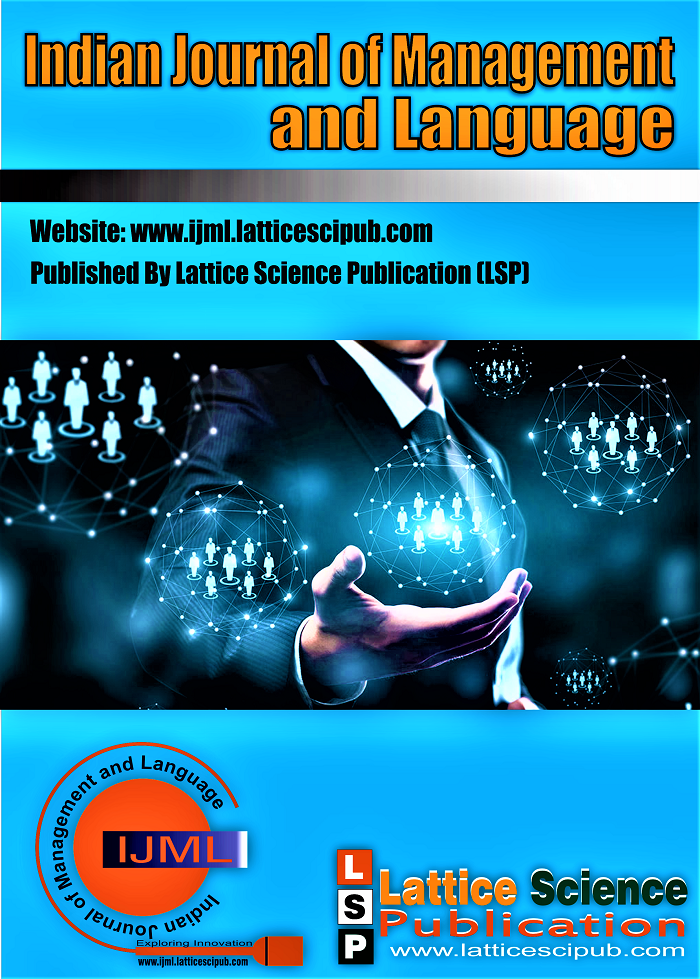Impact of Workplace Alienation on Managers and Engineers
Main Article Content
Abstract
Workplace alienation is described as a state of being in which the employee is demotivated and disinterested in their individualized role and responsibilities at their place of work. The psychological feeling of alienation or separation from their employer and colleagues, and having very little or no passion at all towards their work. This kind of occupational scenario is observed as an implication of certain employer-based actions toward the employee. These actions may comprise being unable to recognize the drive and successes, criticizing the output and the employee, lack of empathy towards the employee, and other issues. This study focuses on understanding the Work Alienation (WA) of Engineers and Managers; and also analyses the influence of sociodemographic features on the OSE among the employee groups. The study was conducted in a major manufacturing Public Sector Unit, located in Mysore. The stratified random sample consisted of up to a hundred and twenty samples selected as per inclusion and exclusion criteria. The data was collected using the WA tool, along with a demographic data sheet. The data was analyzed using statistical tools like Regression analysis, Two-way ANOVA, and Duncan’s Multiple Range Test (DMRT). The results of the study are Engineers and Managers did not differ significantly in their WA scores; the interaction effect between occupation type and different income, age, and years of work experience, are nonsignificant which shows that WA is similar in employees irrespective of the occupation they have. To conclude, WA influences employees' beliefs in their competencies in being able to control their work, thereby over such scenarios that impact them. Beliefs about one’s efficacy influence choices in life, motivation levels, functioning levels, resilient behaviour towards adverse situations, and being vulnerable to stress and its lifethreatening consequences.
Downloads
Article Details

This work is licensed under a Creative Commons Attribution-NonCommercial-NoDerivatives 4.0 International License.
How to Cite
References
Hoy, W., K. Blazovsky, R., and Newland, W., (1983). Bureaucracy And Alienation: A Comparative Analysis. The Journal of Educational Administration, 21 (2), ss.109-121. DOI: https://doi.org/10.1108/eb009872
Bayındır, B. (2003). Relation between Professional Alienation of High School Branch Teachers and Their Behaviours throughout the Teaching-Learning Process. Unpublished Master Thesis, Anadolu University. Institute of Educational Science. (Unpublished Master Degree Thesis)
Blauner, R. (1964) Alienation and Freedom: The Factory Worker and His Industry. Chicago: The University of Chicago Press. https://psycnet.apa.org/record/1965-06019-000
Elma, C. (2003). Teachers Work Alienation in Elementary School (Ankara case study) Unpublished PhD Thesis., Ankara: Ankara University. Institute of Social Science. (Unpublished Master Degree Thesis)
Subberwal R. (2009). Alienation. Dictionary of Sociology. (pp. 9-12). Delhi: Tata McGraw-Hill. (Dictionary). https://www.amazon.in/Sociology-Dictionary-Ranjana-Subberwal/dp/007066031X
Fulcher, J., & Scott, J. (2003). Sociology. Oxford: Oxford University Press. https://global.oup.com/academic/product/sociology-9780199563753?cc=in&lang=en&
Britannica, Encyclopaedia (May 19, 2015). Industrial Revolution. Encyclopaedia Britannica. Retrieved March 10 from http://www.britannica.com/event/Industrial-Revoluton. https://www.britannica.com/event/Industrial-Revolution
McKinsey Global Institute (March 2012). Help wanted: The future of work in advanced economies. Discussion paper. McKinsey & Company. https://www.mckinsey.com/~/media/mckinsey/featured%20insights/employment%20and%20growth/future%20of%20work%20in%20advanced%20economies/help_wanted_future_of_work_full_report.pdf
Kellner D. (2006). New Technologies and Alienation: Some Critical Reflections. (2006). The evolution of alienation: Trauma, promise, and the millennium, Langman, L., & Kalekin-Fishman, D. (Eds) (pp.47-67). Lanham, Md: Rowman & Littlefield Publishers. https://pages.gseis.ucla.edu/faculty/kellner/essays/technologyalienation.pdf
Lawson T., Garrod J. (2001) Deskilling. Dictionary of Sociology. Chicago: Fitzroy Dearborn Publishers. (Dictionary of sociology : Lawson, Tony : Free Download, Borrow, and Streaming : Internet Archive
Asthana V and Verma K (1985). The Work Alienation Scale. Agra Psychological Corporation. India. (A Scale, from Agra Psychological Corporation).
Shantza A., Alfes K. and Truss K. (2012) Alienation from work: Marxist ideologies and twenty-first-century practice. The International Journal of Human Resource Management., 25:18, (pp.2529-2550). London: Routledge. DOI: https://doi.org/10.1080/09585192.2012.667431
Erjem, Y. (2005). The Fenomen of Alienation in Education: A Sociological Research on the High School Teachers. (Elektronik Sürüm). Türk Eğitim Bilimleri Dergisi. 4(3), 2005, from http://www.tebd.gazi.edu.tr/c3s4.html
Akgün, E. (1999). Participation in the Management as an Effective Means of Conflict and Estrangement in Organization. Unpublished Master Thesis, İstanbul: İstanbul University. Institute of Social Science. (Unpublished Master Degree Thesis).
Keerthika. R, Anli Suresh, Role of Public Sector Bank in Financial Inclusion of Low or Middle Income Group in Chennai. (2019). In International Journal of Recent Technology and Engineering (Vol. 8, Issue 4S3, pp. 40–44). DOI: https://doi.org/10.35940/ijrte.d1040.1284s319
Bandaru, D., & Shaik, A. G. (2019). Wavelet-Alienation Coefficient based Protection of Distribution System. In International Journal of Engineering and Advanced Technology (Vol. 8, Issue 6s3, pp. 828–835). DOI: https://doi.org/10.35940/ijeat.f1160.0986s319
Sharma, A., & Singh, B. J. (2020). Evolution of Industrial Revolutions: A Review. In International Journal of Innovative Technology and Exploring Engineering (Vol. 9, Issue 11, pp. 66–73). DOI: https://doi.org/10.35940/ijitee.i7144.0991120
Kaur, K. (2022). The Dilemma of Isolation and Emotional Turmoil: the After Effects of the Pandemic. In Indian Journal of Management and Language (Vol. 2, Issue 2, pp. 1–8). DOI: https://doi.org/10.54105/ijml.d2046.101422





